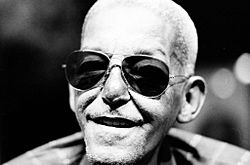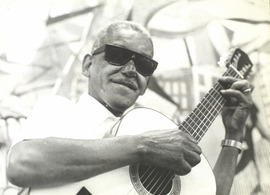Cartola facts for kids
Quick facts for kids
Cartola
|
|
|---|---|
 |
|
| Background information | |
| Birth name | Angenor de Oliveira |
| Born | October 11, 1908 |
| Origin | Catete, Rio de Janeiro, Republic of Brazil |
| Died | November 30, 1980 (aged 72) Rio de Janeiro, Rio de Janeiro, Brazil |
| Genres | samba |
| Occupation(s) | singer, songwriter |
| Instruments | vocal, guitar |
| Years active | 1927–1980 |
Angenor de Oliveira, known as Cartola, was a famous Brazilian singer, composer, and poet. He was born on October 11, 1908, and passed away on November 30, 1980. Many people see him as a very important person in the history of samba music.
Cartola's nickname, "Cartola," means "top hat" in Portuguese. He got this name because he always wore a hat to protect himself when he worked in construction. He wrote over 500 songs, either by himself or with other musicians.
Contents
Biography
Angenor de Oliveira was born in Catete, a neighborhood in Rio de Janeiro. He was the third child of Sebastião Joaquim de Oliveira and Aida Gomes de Oliveira. His parents intended to name him "Agenor," but there was a mistake on his birth certificate, so it became "Angenor." He only found this out when he was 55 years old!
When Cartola was eight, his family moved to the Laranjeiras area. Later, in 1919, they moved to Mangueira hill because they were having money problems. A small favela (a community that grew without official planning, often without public services) was starting to form there. Cartola had to work and give his earnings to his father, with whom he didn't have a good relationship.
By the time he was 17, his mother had passed away, and his father had asked him to leave home. At 18, he met Deolinda, who was seven years older than him, and they got married.
In Mangueira, Cartola quickly became friends with other sambistas (samba musicians). He started to get involved in the world of samba. In 1928, they created a Carnival street band called Arengueiros. This group later became GRES Estação Primeira de Mangueira, which is now one of Brazil's most loved samba schools.
Cartola is believed to have chosen the school's colors: light green and pink. These were the colors of a group called rancho do arrepiados in Laranjeiras. As a boy, he played the cavaquinho (a small guitar, like a ukulele) there, which his father had taught him.
Cartola became well-known in the 1930s and recorded many samba songs. But being famous didn't mean he had a lot of money. To support his family, he worked as a bricklayer, a fish seller, and a cheese seller. His wife sometimes worked as a cook.
Life became harder for Cartola in the late 1940s. At 38, he was very sick for a long time. After he got better, his wife passed away. He wrote one of his most famous songs, "Sim (Yes)," during this sad time. Cartola stopped playing and composing music for a while. He moved with his new wife, Donária, to a community in Nilópolis and worked as a handyman.
In 1952, he met and fell in love with a woman named Zica. They spent the rest of their lives together. Zica encouraged him to start making music again. In 1956, while he was washing cars in Ipanema, a journalist named Sérgio Porto found him. Porto helped Cartola return to the music world. He invited Cartola to radio shows and helped him work with new partners. However, samba wasn't as popular then, so Cartola still had to do other jobs.
In 1963, Cartola, along with Zica and Eugênio Agostine, opened a famous bar and restaurant called Zicartola in downtown Rio de Janeiro. They wanted to share the samba from the favelas with more people. Zicartola became a very important place for samba music. It connected traditional sambistas with the new Bossa Nova style. Cartola invited many great musicians like Nélson Cavaquinho, Pixinguinha, and Nara Leão to perform there.
Cartola's music became very successful in the late 1960s and early 1970s. Many of his classic samba songs were released, such as "O Sol Nascerá" and "O Mundo é Um Moinho." Singers like Elizeth Cardoso and Clara Nunes helped make his songs popular. He released his first record when he was 66, in 1974. Even though he sometimes had money problems, he kept composing and singing until he passed away at 72.
A documentary film about Cartola's life, "Música Para os Olhos," was made in 2007. A book about him, Divino Cartola – Uma Vida em Verde e Rosa, was published in 2013. Cartola and Zica also appeared briefly in the 1959 movie Black Orpheus.
Work
Cartola created the melodies, harmonies, and lyrics for his songs. His lyrics are known for using the Portuguese language very correctly. This is impressive because he didn't have a lot of formal schooling. His poems combine elegance and emotion in a simple way, which made his music easy for many people to enjoy.
Cartola's music often had a calmer, slower rhythm compared to the faster samba songs heard in samba schools. Some people say his sambas were more like samba-canção, a style that is usually slower and more melodic. The cavaquinho in his recordings often had a choro feel, which is a gentle, less percussive style.
As a musician, Cartola used many interesting musical changes in his songs. These changes were not always common in samba at that time. This made his music unique and rich.
Discography
Albums
- 1974 – Cartola
- 1976 – Cartola II
- 1977 – Verde Que Te Quero Rosa
- 1978 – Cartola 70 Anos
- 1982 – Cartola - Ao Vivo
- 1982 – Cartola - Documento Inédito
Contributor
- 1942 – "Native Brazilian Music" – Leopold Stokowski
- 1967 – "A Enluarada Elizeth" – Elizeth Cardoso ("Seleção de Sambas da Mangueira")
- 1968 – "Fala Mangueira!" – Odete Amaral, Cartola, Clementina de Jesus, Nelson Cavaquinho, Carlos Cachaça
- 1970 – "História da música popular brasileira" – with Nelson Cavaquinho
- 1974 – "História das escolas de samba: Mangueira" -Various
- 1975 – "MPB – 100 ao vivo" -Various
- 1980 – "E Vamos À Luta" – Alcione ("Eu Sei")
- 1993 – "No Tom da Mangueira" – Tom Jobim e Velha Guarda da Mangueira (incluída sua gravação de "Não quero mais amar a ninguém")
Tributes
- 1984 – "Cartola, Entre Amigos" – Various
- 1987 – "Cartola – 80 Anos" – by Leny Andrade
- 1988 – "Cartola – Bate outra vez..." – Various
- 1995 – "Claudia Telles Interpreta Nelson Cavaquinho e Cartola" – by Claudia Telles
- 1998 – "Sambas de Cartola" – Grupo Arranco
- 1998 – "Só Cartola" – by Élton Medeiros and Nelson Sargento
- 1998 – "Cartola – 90 Anos" – by Élton Medeiros and Márcia
- 2002 – "Cartola" – by Ney Matogrosso
- 2003 – "Beth Carvalho canta Cartola" – by Beth Carvalho
- 2008 – "Viva Cartola! 100 Anos" – Various
See also
 In Spanish: Cartola (compositor) para niños
In Spanish: Cartola (compositor) para niños


